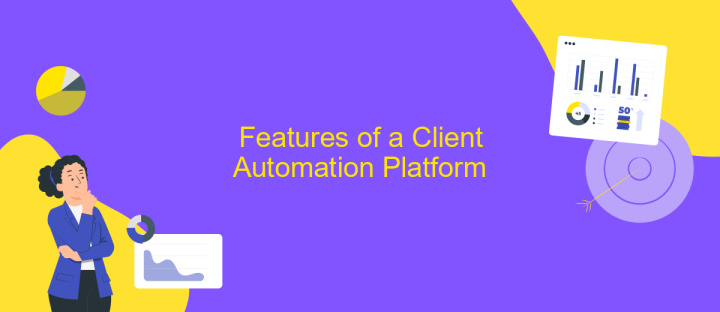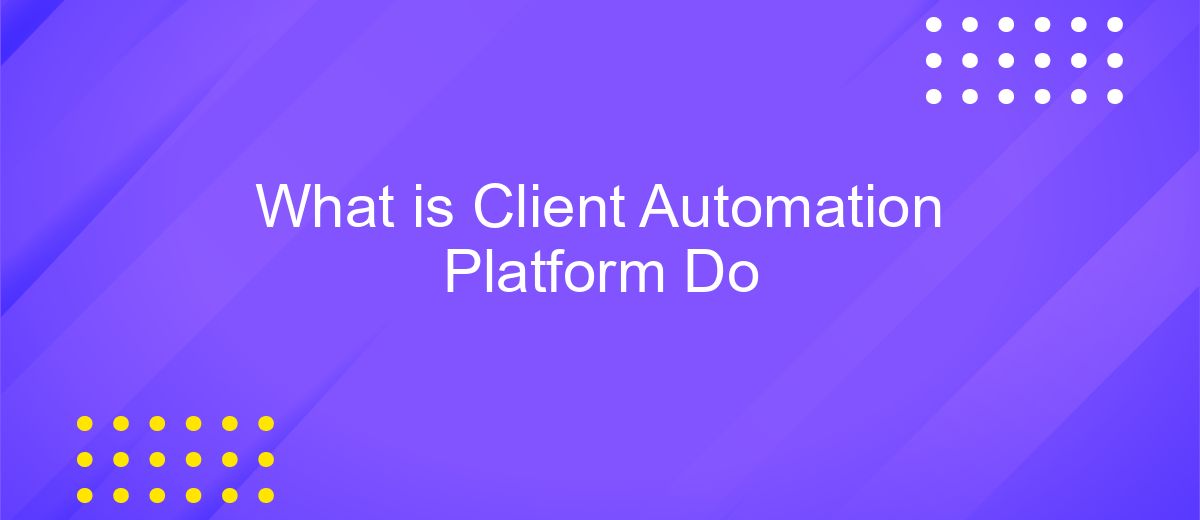What is Client Automation Platform Do
In today's fast-paced digital landscape, businesses are constantly seeking ways to streamline operations and enhance efficiency. A Client Automation Platform is a powerful tool designed to automate client-related processes, from onboarding and communication to data management and reporting. By leveraging advanced technologies, these platforms help organizations reduce manual workload, minimize errors, and improve client satisfaction, ultimately driving business growth and success.
What is Client Automation Platform?
A Client Automation Platform is a comprehensive software solution designed to streamline and automate various client-related processes within an organization. It serves as a centralized hub that integrates different tools and technologies, allowing businesses to efficiently manage client interactions, data, and workflows. By automating routine tasks, this platform enhances productivity and ensures consistency across client engagements.
- Automates client onboarding processes.
- Facilitates seamless communication and collaboration.
- Provides real-time analytics and reporting.
- Ensures data security and compliance.
- Integrates with existing business systems.
Implementing a Client Automation Platform can significantly transform the way businesses interact with their clients. By reducing manual intervention, it minimizes human error and accelerates service delivery. This leads to improved client satisfaction and retention, as clients receive more timely and personalized services. Furthermore, the platform's analytical capabilities empower organizations to make informed decisions, driving strategic growth and competitive advantage. Ultimately, a Client Automation Platform is an essential tool for businesses aiming to optimize their client management processes in today's fast-paced digital landscape.
Benefits of Using a Client Automation Platform

Implementing a client automation platform can significantly enhance operational efficiency by automating repetitive tasks and streamlining workflows. This not only reduces the likelihood of human error but also frees up valuable time for employees to focus on more strategic activities. By automating routine processes, businesses can achieve faster response times, leading to improved customer satisfaction and retention. Furthermore, automation platforms can provide valuable insights through data analytics, enabling companies to make informed decisions and optimize their operations.
Another significant benefit of using a client automation platform is the seamless integration of various applications and services. Platforms like ApiX-Drive offer robust solutions for connecting different software, allowing for smooth data transfer and communication between systems. This integration capability ensures that businesses can maintain a cohesive and efficient digital ecosystem, reducing manual data entry and minimizing the risk of data discrepancies. Ultimately, a client automation platform empowers organizations to adapt quickly to changing market conditions, enhance their service offerings, and maintain a competitive edge in their industry.
Features of a Client Automation Platform

A Client Automation Platform is essential for streamlining and optimizing various client-related processes within an organization. These platforms offer a suite of tools designed to enhance efficiency, improve client interactions, and reduce manual workload. By automating repetitive tasks and centralizing client data, businesses can provide a more consistent and personalized experience for their clients. Below are some key features that define a robust Client Automation Platform.
- Task Automation: Automates routine tasks such as follow-ups, reminders, and data entry, freeing up valuable time for staff to focus on more strategic activities.
- Data Management: Centralizes client information, ensuring easy access and management of data across different departments.
- Workflow Integration: Seamlessly integrates with existing workflows and tools, ensuring smooth operation without disruption.
- Analytics and Reporting: Provides detailed insights and reports on client interactions and processes, helping businesses make informed decisions.
- Customizable Dashboards: Offers customizable interfaces to monitor key performance indicators and client metrics in real-time.
Implementing a Client Automation Platform can significantly enhance an organization's ability to manage client relationships effectively. By leveraging these features, businesses can achieve greater operational efficiency, improve client satisfaction, and ultimately drive growth. Adaptability and scalability of the platform allow it to meet the evolving needs of diverse industries, making it a vital tool for modern enterprises.
How to Choose the Right Client Automation Platform

Choosing the right client automation platform can significantly enhance your business operations by streamlining processes and improving efficiency. The first step is to clearly define your business needs and objectives. Consider what tasks you need to automate and how the platform can support your long-term goals.
Next, evaluate the platform's features and capabilities. Ensure it offers the necessary tools to meet your requirements and is flexible enough to scale with your business growth. It's crucial to assess the platform's integration capabilities with your existing systems to avoid disruptions.
- Determine the ease of use and user interface.
- Check for customer support and training resources.
- Consider the platform's security measures.
- Compare pricing models and total cost of ownership.
Finally, gather feedback from current users and read reviews to understand their experiences. A trial period or demo can also be beneficial to test the platform's functionality firsthand. By carefully considering these factors, you can select a client automation platform that aligns with your business needs and drives success.


Implementation and Best Practices
Implementing a Client Automation Platform (CAP) requires careful planning and execution to ensure seamless integration and optimal performance. Begin by assessing your organization's specific needs and objectives, and select a CAP that aligns with these goals. It's crucial to involve key stakeholders early in the process to gather insights and foster collaboration. Develop a comprehensive implementation plan that includes timelines, resource allocation, and risk management strategies. Training your team on the platform's functionalities is essential for maximizing its potential and ensuring user adoption.
Best practices for CAP implementation include maintaining flexibility to adapt to evolving business requirements and technology advancements. Utilizing integration services like ApiX-Drive can streamline the process by automating data transfers between various applications, reducing manual efforts, and minimizing errors. Regularly monitor and evaluate the platform's performance to identify areas for improvement and ensure it continues to meet your business needs. Establishing a feedback loop with users can provide valuable insights for ongoing optimization. By adhering to these best practices, organizations can effectively leverage CAP to enhance efficiency and drive growth.
FAQ
What is a Client Automation Platform?
How does a Client Automation Platform benefit businesses?
Can a Client Automation Platform integrate with other software?
What kinds of tasks can be automated with a Client Automation Platform?
Is it difficult to set up a Client Automation Platform?
Apix-Drive is a simple and efficient system connector that will help you automate routine tasks and optimize business processes. You can save time and money, direct these resources to more important purposes. Test ApiX-Drive and make sure that this tool will relieve your employees and after 5 minutes of settings your business will start working faster.

